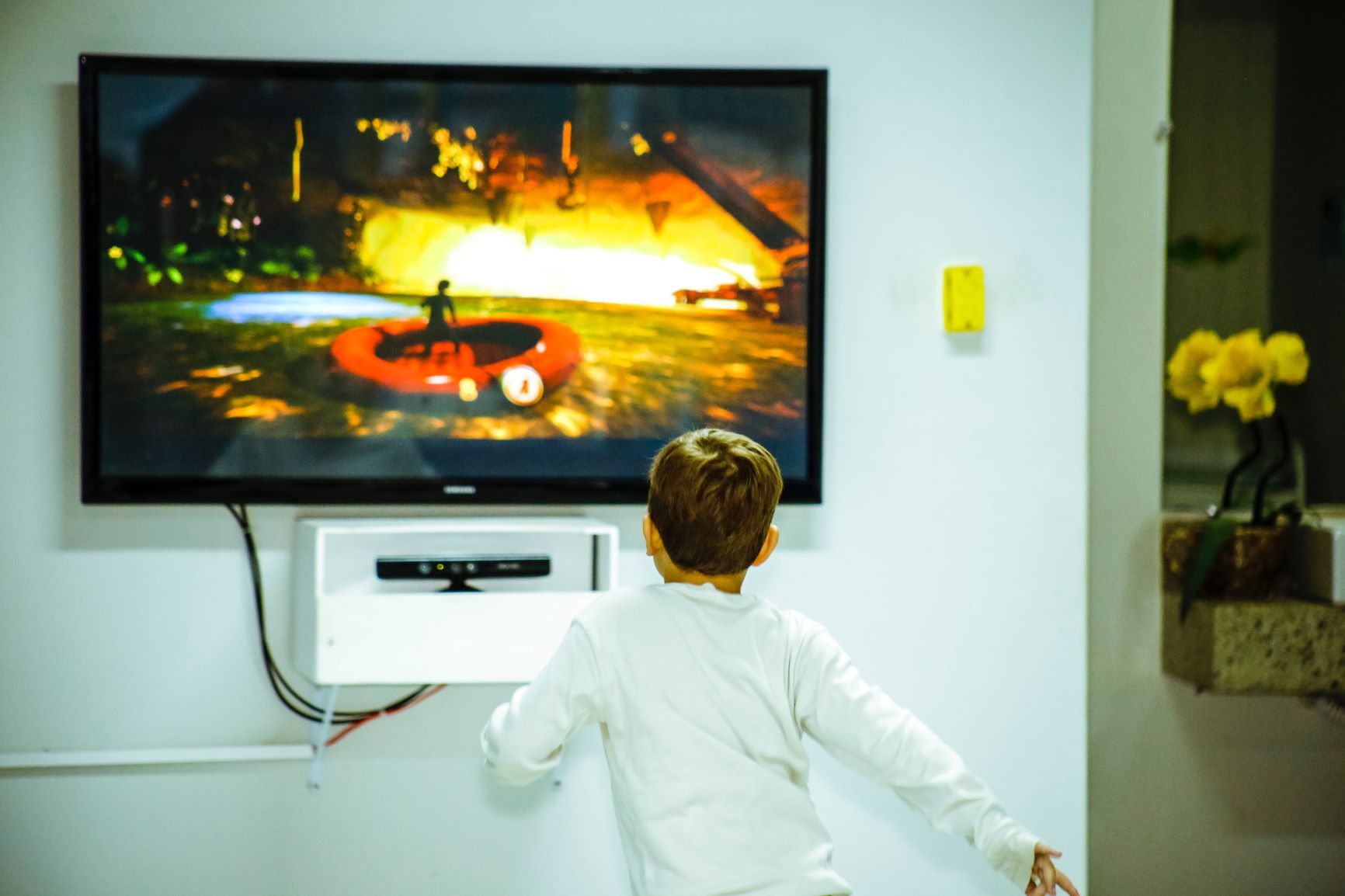“The Genie is out of the Bottle….and we cannot put it back”..…..was the phrase left etched on my mind on the 4th January 2019, as I listened to Professor Russell Viner on Radio 4’s ‘Today’ programme. He was sharing the results of his study: Effect of screen time on the health and well-being of children and adolescents: a systematic review of reviews’.
However, for many radio listeners and parents that day, the ‘take home’ message from the interview with the President of The Royal College of Paediatrics and Child Health, was:
“Parents should worry less about their children’s screen use.”
(BBC News online, Jan 4th, 2019)
Professor Viner stated that, based on the evidence in his study, he was unable to currently advise on how much screen time is safe for children and suggested that parents should: “…do what they do well, which is to balance the risks and benefits’. Perhaps a difficult task to set for most of us, given the mixed and oftentimes contradictory messages flying around in the media about the ‘truth’ of the science on screen use. An air of mass confusion seems to reside in the public arena and my fear is that sometimes it is the easiest and most ‘palatable’ message, out of several that are available, is the one heard. This way, parental worries can be quietly laid to rest, at least for a while…until the next headline hits.
The point is this; scientists are not in the habit of making speculations or suppositions, but are highly trained to only work directly and cautiously from a strong evidence base. Professor Viner repeatedly made this point in the Today programme interview. Despite this, he was challenged by the presenter on several occasions with the fact that parents may be looking for clearer guidance from his expert perspective, a piece of advice slightly more tangible than the somewhat ‘blurry’ line he was offering. However, he remained steadfast and refused to be drawn to broadcast specific screen-time guidelines for UK children.
The United States’ current advice, in stark contrast, is clear. The American Academy of Pediatrics (2016) states that ‘children younger than 18 months should avoid use of screen media other than video-chatting. …and for children aged 2 to 5 years, screen use should be limited to 1 hour per day of high-quality programs’.
Upon reading the RCPCH document, a ‘review of reviews’ (RoR), it soon becomes obvious why the authors were not able to advise on screen time ‘ideals’. As mentioned by Professor Viner, the study simply did not provide the necessary evidence for him to do this. As I see it, there are a number of reasons why this may have been the case. Firstly, as a piece of research, it has many significant limitations; due to constrictions on word count, I will detail just three here.
Perhaps the most important limiting factor was that it analysed just one single ‘high quality’ review of the primary evidence. ‘Primary evidence’ being accounts of original research, study or experimentation. Out of a total number of thirteen included reviews, nine were classed as ‘medium quality’ whilst the remaining three were defined as ‘low quality’.
*(Please see Stiglic and Viner (2019; 2) for full definitions of the terms ‘high, medium and low quality’).
The authors themselves draw attention to the point that there is no ‘best guidance’ on conduct of a ‘Review of Reviews’ and as a research method, RoR’s are “only as good as the reviews included” (Stiglic and Viner (2019; 14) and indeed, the primary data related to them. It is further stated in the RCPCH document that the research “did not seek to evaluate the quality of the primary studies included in each of the reviews” (Stiglic and Viner, 2019; 2).
The next limitation to consider is that as Stiglic and Viner’s review question clearly referred to ‘screen-time’ …one would therefore have expected it to have included data on mobile phones. However, the authors report that: “Data on mobile screen use were particularly limited” and the research was “mostly dominated by studies of television screen time”.
The fact that this fundamentally important point was not made explicit during the Today programme interview or in subsequent media reporting, seemed to me astonishing, especially given that watching television is in fact now known to be an ‘outdated’ screen activity amongst older children. A study published in 2017, found that children aged 12-15 spend the most time per week online (approx. 21 hours), followed by using a mobile phone (approx. 18 hours) and lastly, they watch TV on a TV set for approx. 14 hours, whilst spending the least time gaming (approx. 12 hours). Children aged 8-11 spend comparable periods of time watching television and using the internet (approx. 13 hours 30 minutes), with fewer hours spent gaming or using a mobile phone, though still they engage in phone use for around 10 hours a week. The youngest children (aged 3-4 and 5-7) spend the highest proportion of their screen time each week watching television, followed by going online and then playing video games ( Ofcom (2017) Children and Parents: Media use and Attitudes Report).
Suffice to say, that television viewing is perhaps the least of our worries now as parents of children all heavily armed with mobile phones, tablets, Ipads and gaming consoles.
Whilst all such devices of course have in common one element with television..i.e a ‘screen’ component, clearly the way that each is used, is very different in terms of brain function. The neural networks of a child sitting passively absorbing television images are undergoing a profoundly different experience to those of another playing ‘Fortnite’* on his Ipad… or indeed to another continually scrolling social media news feeds…With all the complex emotional responses involved in using each device and engaging in each activity, the corresponding neurological phenomenon of perception, action and emotion, occur in different ways and by varying degrees.
Neither content nor context of children’s screen use were taken into consideration in the NCPCH study and the report indeed acknowledges that its results must be considered in light of the current lack of understanding around screen use and children’s development.
A further limitation that was not reported in the media, was that the primary data lying behind the RoR was ‘largely self-reported’ or ‘observational’. Both methods of data collection have significant disadvantages as well as certain advantages. Self-reports for example, are subject to a number of biases and limitations, for instance, naturally varying levels of participant honesty and introspective ability and observational research can lack objectivity and results are dependent on the role of the researcher.
The one clear guideline offered in the Today programme interview was to turn off children’s screens one hour before bedtime and two particular potential problems associated with excessive screen use were also mentioned; displacement of sleep and physical activity. Sleep and physical activity are evidently two important issues that, in my mind, make up part of the list of potential harms to children of inappropriate screen use. But even I had not fully realised the extent to which these issues are affecting the lives of families today.
It was just in passing, today in fact, that an extraordinary snapshot of modern-day school life, was given to me:
A young friend of mine, a sports teacher at a well-known preparatory school, happened to be visiting. As we were busy preparing the lunch together, we were chatting about her recent experiences at work and I learned that she and her female colleagues no longer may take boys from Year 5 upwards in any of their sessions. Rather taken back by this fact, I asked her what the reason was for this. She replied in a very ‘matter of fact’ manner:
‘We can’t control them anymore, only the men can.”
I looked at her in amazement…
‘Really??”
She continued: “We can’t allow them to join classes with the girls anymore because they are so aggressive; they were threatening to kill or rape the girls at one point…..so……they now can’t come to do sport with us any longer…”
Her face looks bleak:
“It just all feels out of control; it’s awful.”
I asked her to elaborate further on the situation she was facing.
“It’s because of social media…and because of ‘Fortnite’.
She described how the boys play the online battle game ‘Fortnite’ continuously whenever they were not in school, some setting their alarms at 5am so that they can fit in a full two hours play before getting ready in the morning.
And… as I write this, I reflect back in a moment of day dream to my own childhood in the 1980’s, when I also chose to rise very early….sometimes even at 4am….My addiction however, was horses, my early morning goal… to reach the woods at the top of our village by 5.30, where my best friend would be eagerly waiting on her pony…It was here that we would then revel in a glorious two hours of ‘horse play’ – made all the more delicious by the fact that riding was strictly prohibited here, the wooded copse was owned by the local paper mill and was private land… Cantering up and down those treacherous muddy banks, splashing through shallow streams and jumping gleefully over fallen trees or old boxes and other bits of factory rubbish….these are precious memories that I will never forget….the feel of misty autumn morning air meeting my face, the sight of heavy dew drops hanging on a spider’s web in a tree ….the sweet smell of summer grass after the rain…the sound of early morning bird song…
These children… getting out of their beds to sit in their bedrooms, eyes glued to screens… touch, smell, hearing seemingly disconnected …..taking only virtual risks and experiencing only simulated danger… I feel for them. Secret early morning rides were my experience…..others had different stories, different encounters…. but all were real, all were events full of energy ….life giving somehow. How lucky we were to grow up in a different era….one where real life adventure was just normal.
The definition given by the Collin’s English dictionary of Professor Viner’s phrase ‘letting the genie out of the bottle’ is that it means “something has happened which has made a great and permanent change in people’s lives, especially a bad change”.
Many parents, teachers and some researchers even, instinctively feel that a bad change has and is still happening in relation to children’s excessive use of screens. And each one of us, in our own individual way, are struggling with what we should do about it.
The RCPCH study, though unable to advise on screen time thresholds for children from its results, did report that their data “broadly support policy action to limit screen use by children and young people because of evidence of health harms across a broad range of domains of physical and mental health” (Stiglic and Viner, 2019; 14). It specifies that: “There is considerable evidence that higher levels of screen time is associated with a variety of health harms for CYP, with evidence strongest for adiposity, unhealthy diet, depressive symptoms and quality of life.” (ibid; 1)
Though as we know, for some reason, these were not the points that made the international news headlines.
Instead it was, for example: ‘Stop scaremongering about kids spending too much time on their phones’ (New Statesman, 4th January 2019).
The title of Ben Goldacre’s witty 2015 book highlighting the issue of science being twisted by the media springs to mind: “I Think You Will Find It Is A Bit More Complicated Than That’.
My hunch anyway with regard to this particular news story is that UK’s parents will have switched off their radio or their computer more confused than they were before …or worse still, thinking they need not be concerned about screens at all.
For me, as a researcher interested in the value to the young, developing brain of spontaneous, as opposed to ‘goal-directed’ thinking, I am considering screen time in terms of time displacing important opportunities to day dream. What I would like to know is this:
What does excessive goal-directed screen time mean for the development of the brain network that helps to serve psychological processes such as day dreaming and play? Given that this, the Default Mode Network, is also strongly associated with social and emotional processing, and perhaps most profoundly, is involved with development and maturation of psychological phenomenon such as empathy and moral reasoning – processes of Self – what precisely is it, on a psychological and neural level, that excessive screen time might be taking away from children?
This, I think, is an intense and complex question….a far reaching and important one indeed….and it is way beyond the scope of this essay to find its answer.
However, I cannot help but want to know whether this ‘bolted Genie’, seemingly running wild and creating havoc amongst our young, could in fact, be the same one responsible for the creation of ‘Generation Snowflake’ …those apparently sad, young adults of the 2010s who are “more prone to offence, have less psychological resilience than those before them and who are too emotionally vulnerable to cope with views that challenge their own”..(Wikapaedia.org, 2019).
We need to find the evidence of course, but I guess… it is possible.
Sarah Rees, January 2019.
Copyright notice
This article is copyright of Sarah Rees – © SR Educational Research (2019). All rights reserved.
Any redistribution or reproduction of part or all of the contents in any form is prohibited other than the following:
- you may print or download to a local hard disk extracts for your personal and non-commercial use only
- you may copy the content to individual third parties for their personal use, but only if you acknowledge the author and website as the source of the material.
You may not, except with my express written permission, distribute or commercially exploit the content of this article. Nor may you transmit it or store it in any other website or other form of electronic retrieval system.
All correspondence please contact Sarah Rees at info@sarah-rees.co.uk
References
American Academy of Pediatrics (2016)
Accessed online at: https://www.aap.org/en-us/about-the-aap/aap-press-room/Pages/American-Academy-of-Pediatrics-Announces-New-Recommendations-for-Childrens-Media-Use.aspx
Date Accessed: 5th January 2019
BBC News Online, January 4th, 2019.
Accessed online at: https://www.bbc.co.uk/news/health-46749232
Date accessed: 12th January 2019
New Statesman (2019)
Accessed online at: https://www.newstatesman.com/politics/uk/2019/01/stop-scaremongering-about-kids-spending-time-their-phones
Date Accessed: 16th January 2019
Ofcom (2017)
Accessed online at: https://www.ofcom.org.uk/__data/assets/pdf_file/0020/108182/children-parents-media-use-attitudes-2017.pdf
Date Accessed: 14th January 2019
Stiglic N, Viner RM. (2019) Effects of screen-time on the health and well-being of children and adolescents: a systematic review of reviews. BMJ Open 2019; 9:e023191. doi:10.1136/ bmjopen-2018-023191
*Definition of ‘Generation Snowflake’
Accessed online at: https://en.wikipedia.org/wiki/Generation_Snowflake
Date Accessed: 16th January 2019
*Image on original Kindling article by Gwendolyn Berndt-Kuchel (Pinterest.com)




